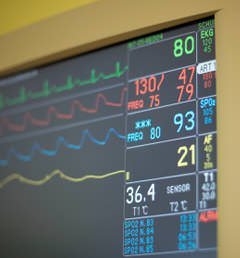Intraoperative hypotension (and to a lesser degree, hypertension) are very common issues which can occur in any case, so it’s important to have a methodical approach in diagnosing the etiology as well as treating it.
BLOOD PRESSURE
Let’s start with the basics – “blood pressure” (BP) conventionally refers to the pressure exerted by arterial blood on vessel walls. It’s the product of cardiac output (CO) and systemic vascular resistance (SVR). The vasculature (namely the arterioles) adjust SVR through vessel constriction or dilation based on autonomic nervous system regulation.
So BP = CO x SVR, and SVR accounts for 95% of impedence to blood ejection from the heart (“afterload”).
CO = HR x SV – Heart rate (HR) is affected not only by the rate but the cardiac rhythm. Stroke volume is a function of preload, cardiac contractility, and afterload based on the Frank-Starling law of the heart.
Pulse pressure (PP) is the difference between the systolic BP (SBP) and diastolic BP (DBP). A normal value is ~40 mm Hg. Narrow PPs could be due to aortic stenosis, coarctation, tension pneumothorax, or shock. Wide PPs can be from aortic regurgitation, atherosclerotic vessels, or high cardiac output states.
Mean arterial pressure (MAP) is roughly the average pressure during one cardiac cycle and is frequently used in the OR. MAP = 2/3(DBP) + 1/3(SBP)
BP MEASUREMENT
- Noninvasive blood pressure (NIBP) cuff: an oscillometric BP determination as the cuff deflates. MAP is measured as the largest oscillation. SBP and DBP are calculated by proprietary algorithms.
- Invasive arterial blood pressure (IABP): cannulation of an artery (typically radial) with SBP, DBP, and MAP being accurately and continuously measured by a transducer
INTRAOPERATIVE HYPOTENSION
- Excessive anesthesia depth: overdose of induction agent, volatile, or narcotic
- Inadequate preload: hypovolemic shock, anemia, relative dehydration from fasting
- Increased intrathoracic pressure: high PEEP, high I:E ratio, pneumothorax
- Reduced afterload: vasodilated states like liver failure, sepsis, SIRS or depleted catecholamines from adrenal suppression, cocaine, amphetamines. Spinal anesthesia causes a sympathectomy thereby decreasing SVR.
- Other: acute MI, non-perfusing arrhythmias, cardiomyopathies, valvulopathies, pulmonary hypertension
Always start with an evaluation of five basic factors: preload, contractility, afterload, heart rate, heart rhythm.
Maybe the patient is too deeply anesthetized and I need to decrease the volatile agent? If preload is a concern, maybe a fluid bolus will help? Maybe a small dose of neosynephrine will help increase the afterload? Is the estimated blood loss (EBL) being replaced appropriately? Reevaluate the deficit, maintenance, and ongoing fluid losses – urine output and color can help gauge your repletion strategies. Transesophageal echo (TEE) can give valuable information about filling status, contractility, valvular disease, or effusions which may also be contributing. Auscultate the lungs, reduce PEEP, and shorten the ventilator inspiratory time if intrathoracic pressure is a concern. Double-check that electrolytes and acid-base equilibria are in check.
VASOPRESSORS
Neosynephrine (phenylephrine)
- Alpha-1 agonist => causes direct vasoconstriction
- Improves SVR but can cause reflex bradycardia
- Dose: 100 mcg IV q 2-3 minutes
- Indirect sympathomimetic (alpha-1, beta-1, and less so beta-2 receptor agonist)
- Causes the release of endogenous catecholamines causing an increase in HR, BP, and contractility. Consider conditions in which catecholamine stores may be exhausted if not responsive to ephedrine
- Clinically useful in patients who are vasodilated, bradycardic, and low output states
- Dose: 5-10 mg IV q 3-5 minutes
- The “big gun” pressor – direct sympathomimetic on alpha and beta receptors
- Used for acute, profound hypotension or refractory hypotension
- Increases vasoconstriction, HR, and SVR
- Dose: 10 mcg IV q 3-5 minutes – escalate from there
Dopamine (infusion)
- Mechanism depends on the dose
- 0.5-2.0 mcg/kg/min => mesenteric, coronary, renal dilation (dopamine agonist)
- 2.0-10.0 mcg/kg/min => increased myocardial contractility and heart rate (beta-1 agonist)
- 10.0-20.0 mcg/kg/min => increased vasoconstriction (alpha-agonist)
Always keep adrenal suppression in the differential for hypotension (especially for those recently on steroids). A small dose of hydrocortisone can go a long way.
INTRAOPERATIVE HYPERTENSION
- Light anesthesia
- Pain
- Chronic hypertension,
- Illicit drugs: cocaine, amphetamines
- Hypermetabolic state: malignant hyperthermia, thyrotoxicosis, neuroleptic malignant syndrome
- Increased intracranial pressure (ICP): Cushing’s triad – hypertension, bradycardia, and irregular respirations
- Autonomix hyperreflexia (spinal cord lesions above T5 are severe, lower than T10 are mild)
- Endocrine: pheochromocytoma, hyperaldosteronism
Just as with hypotension, the treatment for hypertension centers around temporizing the situation with fast onset, short-acting drugs and treating the underlying cause above all else.
If the patient is too lightly anesthetized, consider bolusing 10-20 mg propofol and cranking up the volatile (this may take longer to produce a result). If pain is the culprit, bolus 25-50 mcg fentanyl for additional analgesia. Beta blockers are always available (metoprolol, labetalol, esmolol) and vasodilators like hydralazine are often used for permissive hypotension to improve the surgical field and minimize blood loss.






